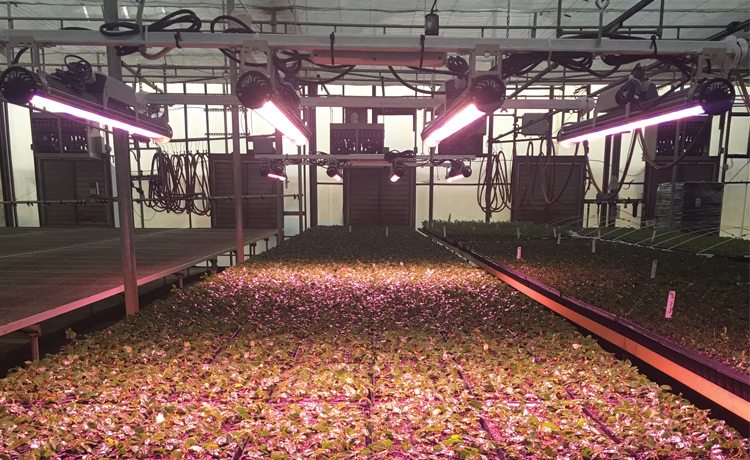One horticultural lighting company’s new adaptive LED lights literally communicate with plants to control the amount of light they receive.
_x000D_
In an effort to grow plants at a faster rate, two men — one a physicist and the other a biological and agricultural engineer — formed a horticultural lighting company that literally allows the lights to communicate with plants to determine optimal lighting conditions._x000D_
_x000D_
_x000D_
In 2013, cofounders Erico Mattos, chief technology officer, and Ryan Hunt, commercial adviser, brought to life PhytoSynthetix in Athens, Georgia, to commercialize an innovative technology developed at the University of Georgia during their graduate studies._x000D_
_x000D_
“We identified an opportunity to apply the biofeedback lighting control technology — initially developed to improve micro algae production — toward the fast-growing market of vegetables and flowers in controlled environmental systems,” Mattos shares. “We combined a deep understanding of plant physiology with biological engineering to develop a system that allows us to develop lighting solutions based on plants’ photosynthetic parameters._x000D_
_x000D_
“Our goal is to reduce the operational costs associated with artificial lights and improve controlled environment agriculture (CEA) facilities management.”_x000D_
_x000D_
PhytoSynthetix specializes in ultra-high performance LED illumination systems. The technology identifies individual crops’ lighting requirements, and provides the necessary amount of light to ensure fast crop development and maximize biomass production with minimal energy use._x000D_
_x000D_
Mattos says in CEA facilities, light levels are often arbitrarily chosen with limited control over supplemental lighting systems, other than turning them on and off. It’s also not known how efficiently plants use artificial light. Energy waste, high electric bills and poor predictability of crop production can result._x000D_
_x000D_
PhytoSynthetix’s new adaptive LED lights offer energy savings and production predictability. Mattos says the energy savings can be high as 60 per cent._x000D_
_x000D_
How Do Smart Lights Works?_x000D_
_x000D_
Essentially, PhytoSynthetix technology identifies individual crops’ light requirements and uses an autonomous LED lighting system to maintain the required light levels, based on external conditions._x000D_
_x000D_
A biofeedback system monitors plants’ light use efficiency and determines how much light is required to maintain optimum photosynthetic rates. This feedback system is based on chlorophyll fluorescence measurements that allow the LED grow light to “communicate” with the plants and adjust its light output to minimize the energy dissipated as heat and optimize photosynthesis._x000D_
_x000D_
“Using the biofeedback system, a light profile is generated to identify the point of diminishing returns,” Mattos says. “This increases light levels to provide minimal increases in biomass production — and the minimal amount of energy necessary for plant development. It indicates the highest light use efficiency at different stages of plant development ensuring consistent production cycles.”_x000D_
_x000D_
The LED lights can also sense the external environment and adapt to the lighting conditions. Each adaptive light is equipped with light sensors and control software capable of sensing incoming light. The adaptive lights provide just the necessary amount of supplemental light to ensure that the combined light from the sun and LEDs does not drop below the crop-specific lighting target provided by the lighting profile._x000D_
_x000D_
Ready. Set. Launch._x000D_
_x000D_
_x000D_
Since the company’s incorporation three years ago, Mattos and Hunt have secured investments to finalize the technology development._x000D_
_x000D_
“We are now at the commercialization phase,” Mattos says, adding that the first commercial lighting system was implemented in November._x000D_
_x000D_
As part of its launch, Mattos is targeting those in the research, vegetable, pharma and greenhouse business — sectors that focus on the initial phase of plant production (five to 20 days)._x000D_
_x000D_
“Initial plant development is crucial to ensure physical integrity and healthy plant growth,” Mattos explains. “The high value of seedlings means that it is easier to get a return on investment in new technologies that improve seedling production, reducing the barrier to adopt our new technology.”_x000D_
_x000D_
Helping Mattos and Hunt understand the ins and outs of the horticulture industry is Marc van Iersel, a university professor. His past work has focused on the irrigation and fertilization of greenhouse crops, but this has recently shifted toward more efficient supplemental lighting practices._x000D_
_x000D_
“I met Mattos when he was a graduate student at the University of Georgia,” van Iersel recalls. “I was a member of his advisory committee and he was a student in my graduate level photosynthesis class. One topic that came up was the idea of controlling lighting in greenhouses or growth rooms based on the crop’s physiological ability to use that light.”_x000D_
_x000D_
After graduation, Mattos cofounded PhytoSynthetix with Hunt, who had also taken van Iersel’s photosynthesis class. Their company was formed in part based on some of the ideas brought up in class. Since its founding, van Iersel has collaborated closely with PhytoSynthetix to help make that idea a reality._x000D_
_x000D_
Given van Iersel’s close association with PhytoSynthetix, he remains excited about their joint work._x000D_
_x000D_
“Supplemental light currently is not controlled in any advanced way,” van Iersel says. “It’s largely a best guess by the grower. PhytoSynthetix will provide growers the ability to make lighting decisions based on sound scientific principles._x000D_
_x000D_
“The company also has developed technology — in collaboration with my lab — to help growers implement ‘smart’ lighting strategies. This approach will only provide crops with supplemental light when the plants can use that light efficiently._x000D_
_x000D_
“As more sunlight is present, their LED lights automatically dim, because the crop does not need as much supplemental light when there is ample sunlight. This can greatly reduce lighting costs for greenhouses.”_x000D_
_x000D_
Van Iersel says this LED illumination system is especially beneficial for growers who produce high value seedlings, such as vegetable or ornamentals. “PhytoSynthetix’s approach has the potential to change the economics of supplemental lighting,” he says. “At the same time, it may make it easier to produce crops on a schedule. That can have big benefits, because it can remove much of the uncertainty of scheduling subsequent crops.”














